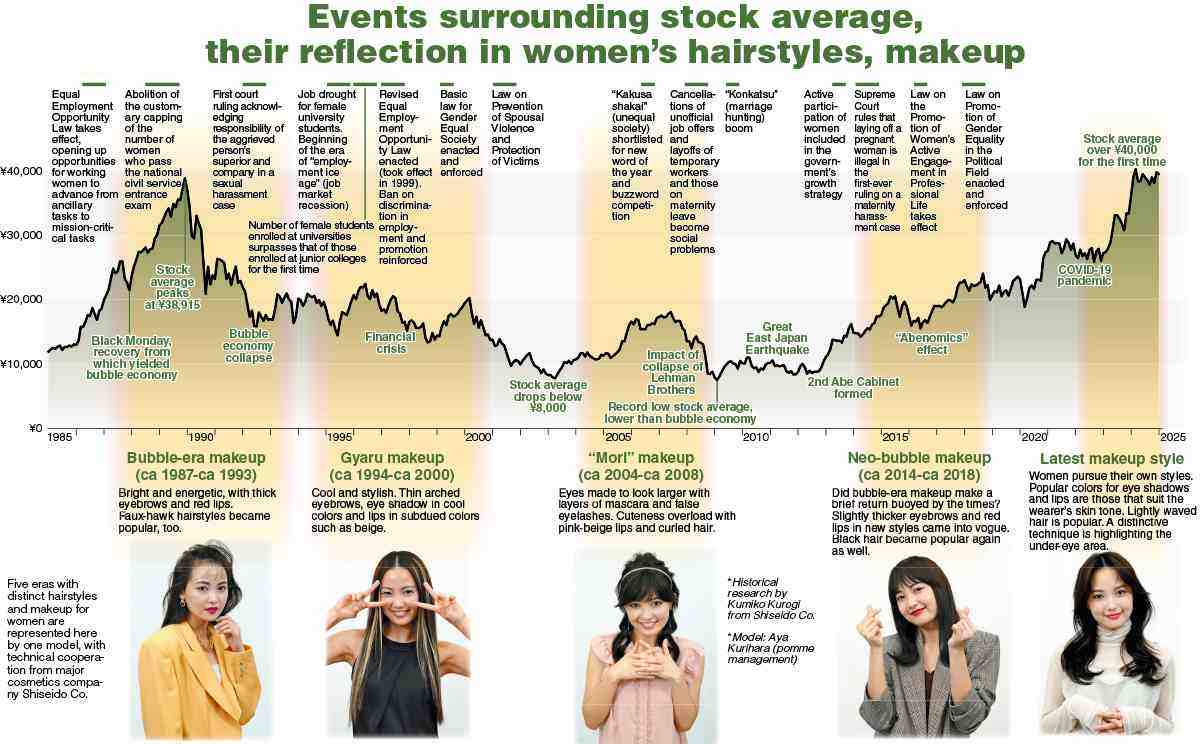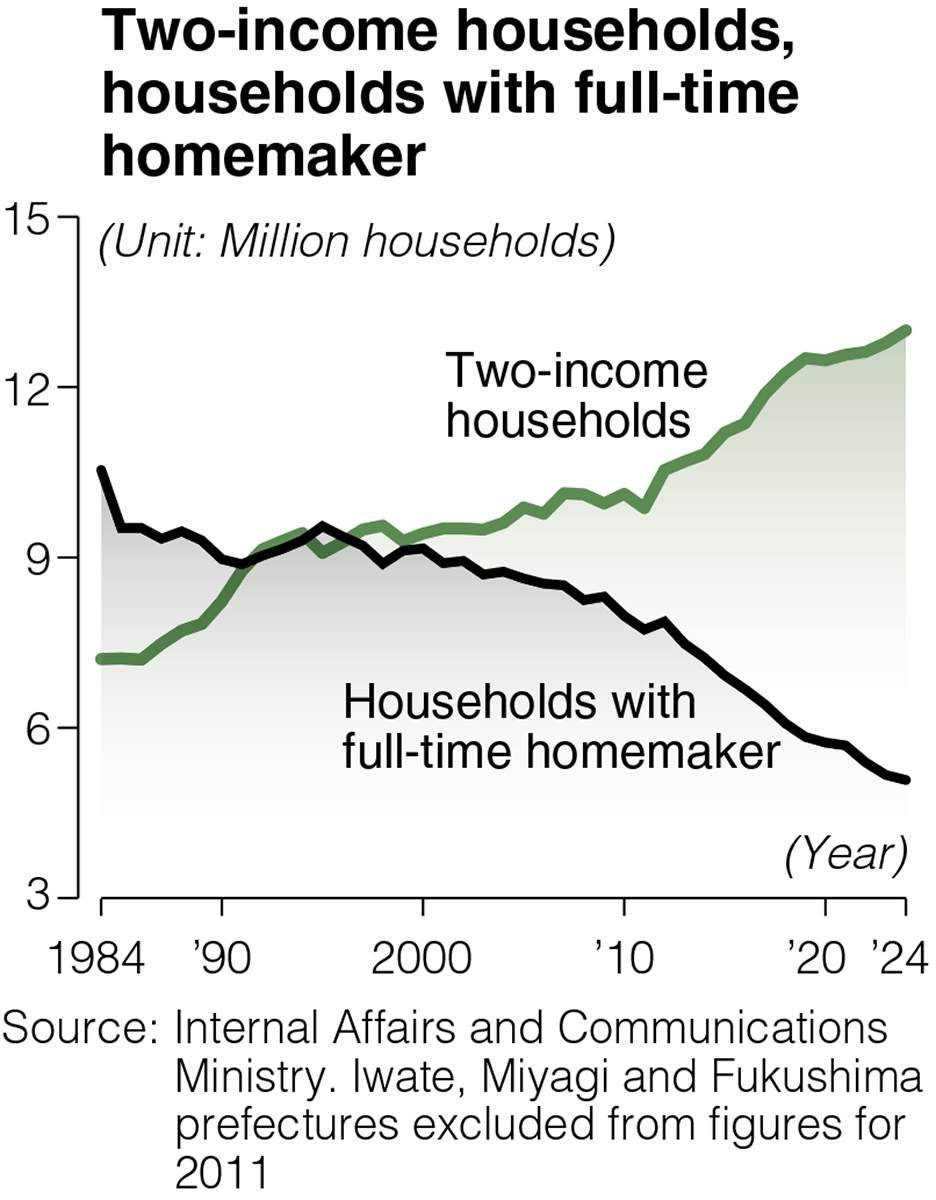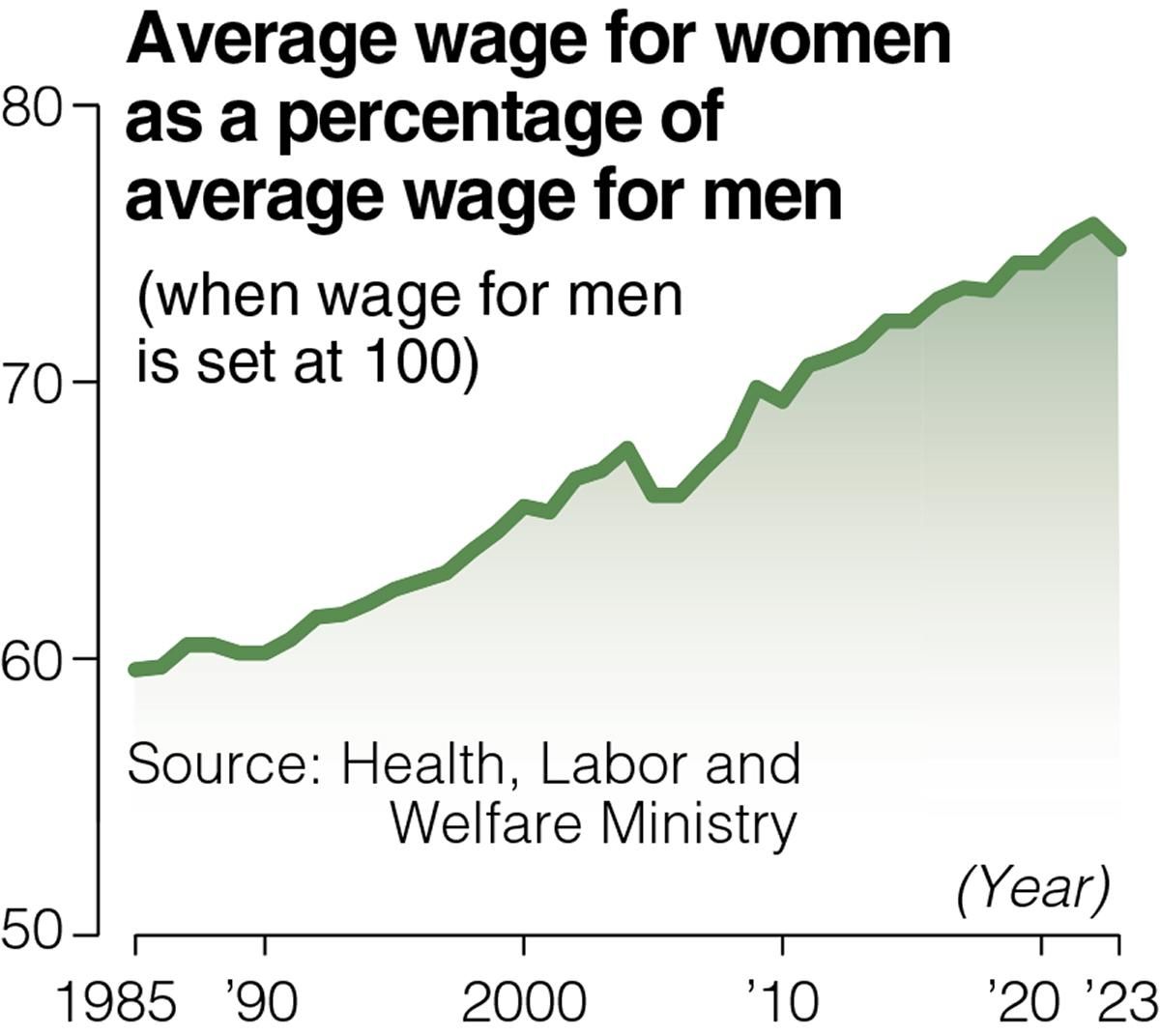
11:48 JST, April 23, 2025
It has been 40 years since the Equal Employment Opportunity Law was enacted. Since the enactment of the law, which was the fist step to eliminate gender discrimination in job opportunities, efforts have been made to promote the development of an environment in which women can work comfortably.
The way women are perceived — from powerful to sweet — has been reflected in economic and social developments up to the present day.
Career-track positions
The law was enacted in 1985. That same year, the then Group of Five advanced nations signed the Plaza Accord, which was aimed at taking coordinated action to address the appreciation of the U.S. dollar. The yen rapidly appreciated after that, and monetary easing and measures to expand domestic demand served as a catalyst for an unprecedented economic boom.
What followed for the Japanese economy was an economic bubble, with the benchmark Nikkei-225 stock average climbing to a then record ¥38,915 by the end of 1989.
Companies hired many new graduates and crawled over each other to lock in new recruits as quickly as they could. Women, who had previously been given supportive positions in the workplace, began to be offered promising career opportunities under the new law, putting them on track to secure even managerial posts.
However, at the time it was enacted, the law required nothing more than for companies to make an effort to treat women equally as men in terms of employment, placement and promotion.
Wearing power suits with large shoulder pads was popular at the time among career women who wanted to demonstrate their abilities and show their desire to have a meaningful career.
‘Gyaru’ makeup
In the early 1990s, the bubble economy collapsed, and Japan entered a long period of stagnation, later dubbed the “three lost decades.” Affordable cosmetics became popular, and “gyaru” — a fashion subculture named after the Japanese pronunciation of the English word “gal” — enjoyed a boom even among working-age women.
Even during the recession, an environment in which women could work comfortably steadily advanced.

In 1989, a former female employee of a publishing company who claimed that she had suffered verbal sexual harassment filed a lawsuit against her boss and company, seeking damages for emotional distress and other harm. The court ruled that her male boss and the company were responsible for the harassment in what became known as the nation’s first “sexual harassment lawsuit.” That ruling came in 1992, when harassment was far from a widespread concept.
In 1999, the law was revised to obligate employers to consider measures to prevent sexual harassment. The law also obliged employers not to discriminate against women in terms of hiring, placement and promotion.
For a long time, a majority of households were made up of a husband who worked and a wife who was a full-time homemaker. However, in 1992, those households were eclipsed by two-income households for the first time. Since 1997, two-income households have been in the majority, and the gap between the two continues to expand.
Focus on charms
The economic doldrums continued. In 2003, the Nikkei stock average fell below ¥8,000 for the first time in 20 years. With the structural reform policies of then Prime Minister Junichiro Koizumi, it became easier for companies to employ temporary workers, leading to a sharp increase in the number of both men and women in non-regular employment.
Working part-time used to be just one of the work options available to women, but after the structural reform policies, more and more women were unable to find full-time employment and had no choice but to work with unstable employment.
In 2006, the word of the year was “Kakusa shakai” (unequal society), picked from among the new and popular expressions that year.
In 2008, Japanese companies were affected by the “Lehman Shock,” a global credit crunch triggered by the collapse of U.S. investment bank Lehman Brothers, and social issues emerged such as unilateral termination of temporary employment contracts.
Under the prolonged recession, there was a boom in “konkatsu” (marriage hunting), advocated by Prof. Masahiro Yamada of Chuo University and journalist Toko Shirakawa. Hair and makeup styles that emphasized the charm and attractiveness of women became popular.
3 arrows, red lipstick
The economy began to recover after the launch of Abenomics, an economic policy promoted by former Prime Minister Shinzo Abe after his return to power in 2012. The economic policies of Abenomics were based on three “arrows” — aggressive monetary policy, flexible fiscal policy and structural reform of the economy — and aimed to navigate a way out of a deflationary period.
In 2013, the government put an active role for women in society at the center of its growth strategy. In 2016, it passed the Law on Promotion of Women’s Active Engagement in Professional Life, which obliges major companies to set numerical targets for women in managerial posts and to compile and publicize action plans for fostering the active participation and advancement of women.

Investors and consumers paid attention to whether women were being fairly evaluated at the workplace and allowed to demonstrate their abilities there. Reflecting economic recovery and the support that society was providing to women, red lips and other heavy makeup reminiscent of the bubble period became popular.
In 1985, the wage for women was 59.6 compared to 100 for men, but that figure rose to beyond 70 in the 2010s, according to a survey by the Health, Labor and Welfare Ministry. Narrowing the gap, however, has not been easy.
COVID-19, individuality
In 2018, the Law on Promotion of Gender Equality in the Political Field was enacted in order to facilitate women’s participation in politics.
The COVID-19 pandemic, which started in 2020, caused a contraction in economic activity, leading many people in non-regular employment, regardless of their gender, to find themselves in a difficult situation.
The economy gradually recovered, and in 2024 the benchmark Nikkei stock Average topped the ¥40,000 mark for the first time. Although it fell sharply afterward, it has since remained relatively firm.
After a long period of pandemic-induced mask wearing, women have come to place more importance on their individuality. “Personal color analysis,” for instance, a method that helps people determine which colors best suit their skin tone, and other novel ideas are gaining recognition.
The way people do their job has changed, with more employees working from home and other places besides corporate offices. Japan is heading to a future where both men and women can lead their lives as they please.
***
From high heels to sneakers
There have been significant changes around women’s feet in the past 40 years.
During the bubble economy years, career women chose high heels.
“Pumps with 7.5-centimeter heels were overwhelmingly popular,” said Miyako Sekimoto, a fashion director of Matsuya Ginza department store, looking back on those years.
When the economy cooled in the 1990s, women’s heels lowered to about 5.5 centimeters. The preferred color was black, and pumps with a simple shape and pointy toes were popular.
Following the Great East Japan Earthquake in 2011, shoes with low heels and flat shoes became part of women’s preferences, as many women became aware that they might have to evacuate or go home on foot in emergencies.
In 2019, the so-called “#KuToo” movement occurred, in which women demanded that companies and society not force them to wear pumps. The movement derived from the “Me Too” movement and was a pun on the Japanese words “kutsu” (shoe) and “kutsuu” (pain).
Today, casual loafers and sneakers are widespread as well.
“Women have become able to wear shoes that suit them,” Sekimoto said.
— By Kie Noguchi and Mako Nagaiwa









